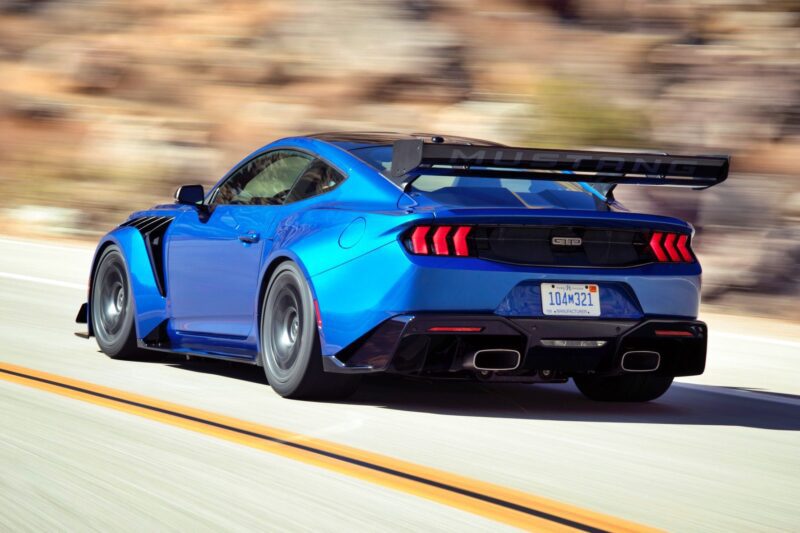First Drive: Six-figure Ford Mustang GTD Boasts Peak Pony Muscle
by Basem Wasef
in Ford News, Mustang, Reviews
If you think spending Lambo money on a Mustang is madness, Jim Farley would like to have a word with you. The Blue Oval CEO’s fondness for the O.G. pony car makes the 7-and-sometimes-8-figure-per-year exec seem more like Joe Six Pack than a captain of industry.
But his ‘Stang fanboying comes from the heart: he restored a 1964 ½ basket case at 15, acquired a ’65 Shelby GT350 years later, and has tracked all manner of Mustangs in between. Farley’s championing of the platform is well documented and was perhaps most clearly expressed when he shielded the Mustang from extinction during Ford’s 2018 shift to building only trucks, crossovers, and SUVs.
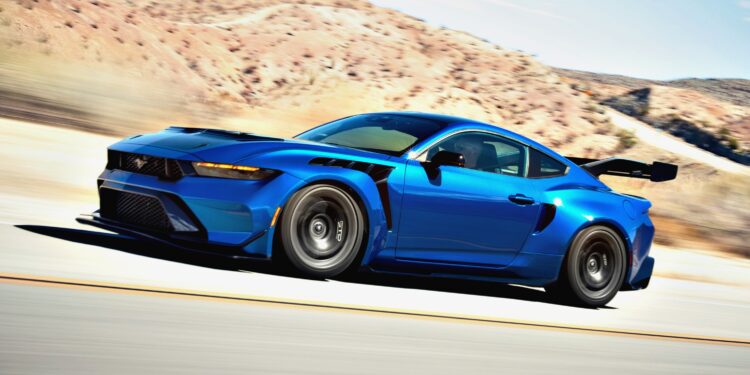
The big boss also embiggened the Mustang by throwing the model into a slew of race series, most critically GT3, where the humble American pony car competes against nameplates like Aston Martin, Ferrari, Lamborghini, and McLaren. When contextualized against those ultra-fancy competitors, a heavily spoilered, flared, vented, and $325,000 Mustang GTD starts to make a tiny bit more sense.
“Mustang is the flagship race car of the Ford Motor Company, and pretty much any given weekend we’re racing one somewhere,” GTD chief program engineer Greg Goodall told duPont Registry at the vehicle’s media launch in Thermal, CA. “We’re competing against the exotic European carmakers. Why wouldn’t we compete with them on the road?”
The first goal when building the baddest ass Mustang in all the land was establishing a killer Nürburgring time. “You can’t just tell people we’re like Porsche,” insists Goodall, “you have to measure it in some way.” Hence, the sub-7-minute time target.
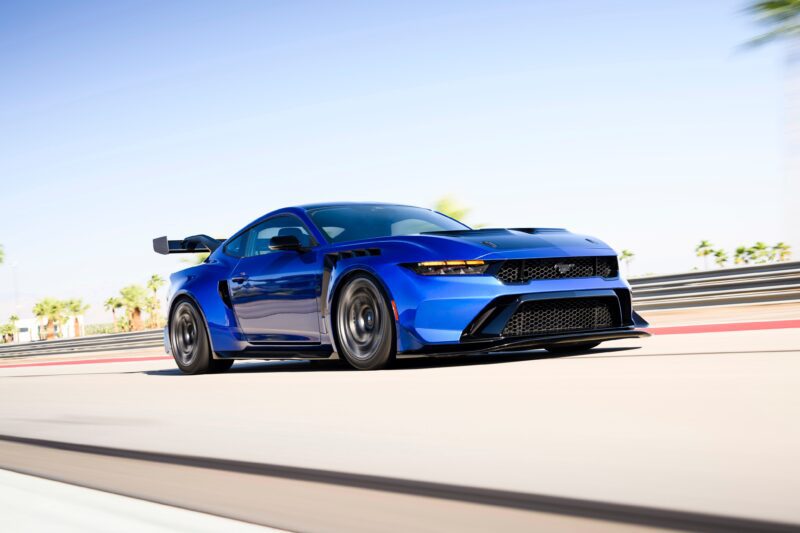
Things didn’t initially go as planned, as only three officially timed laps transpired in 2024 due to the weather at the 12.9-mile circuit. While an August run achieved 6:57.685, the team felt there was room for improvement, which inspired chassis, suspension, and aero tweaks, along with revisions to ABS and traction control tuning.
In May of 2025, Dirk Müller found 5.6 seconds, elevating the 815-horsepower muscle car’s 6:52.072 time just behind the Porsche 911 GT3 RS (6:49.328), Mercedes-AMG GT Black Series (6:48.047), and the Mercedes-AMG One (6:29:090). Even though GTDs are already in the hands of paying customers, Ford Performance says they’re still chasing a quicker lap time around the Eifel Mountain course.
Like that other performance-focused strain linked to international competition, the Ford GT, the GTD was executed through a deep collaboration with Multimatic. The transmogrification starts with a run-of-the-mill Mustang’s body-in-white that gets plucked from Ford’s Flat Rock, Michigan, plant to Multimatic HQs in Ontario.
The Mustang’s body-in-white is shipped without front fenders or a hood, which Multimatic replaces with a massively flared and vented pair of fenders and a carbon fiber hood with removable top grilles for track use. Deep surgery begins by plasma cutting and removing the second row, the rear floor, and the outer shell.
Much of that negative space gets filled with the Tremec 8-speed dual-clutch transaxle, which helps deliver near-perfect 50/50 weight distribution. Up front is an evolution of the Predator supercharged 5.2-liter V8 found in the GT500 and Raptor R, tuned to 815 horsepower and 664 lb-ft of torque. This application uses dry sump lubrication and drives power through a carbon fiber propshaft – all proper racecar stuff.

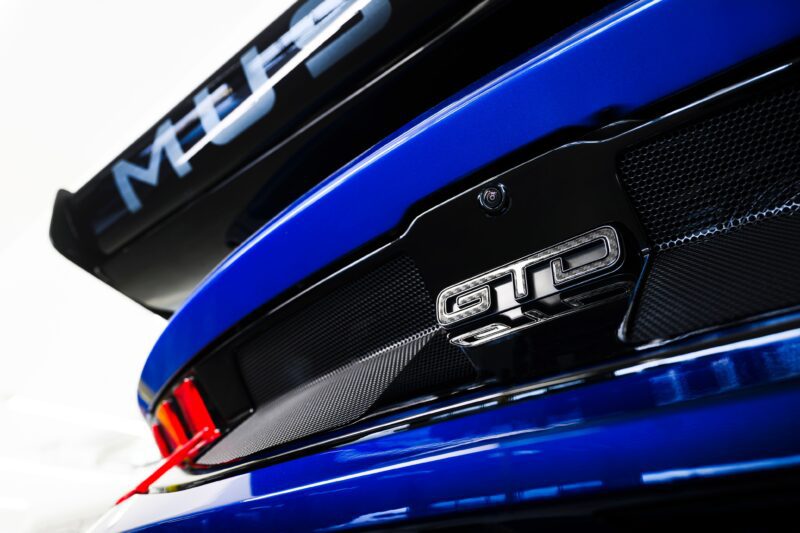
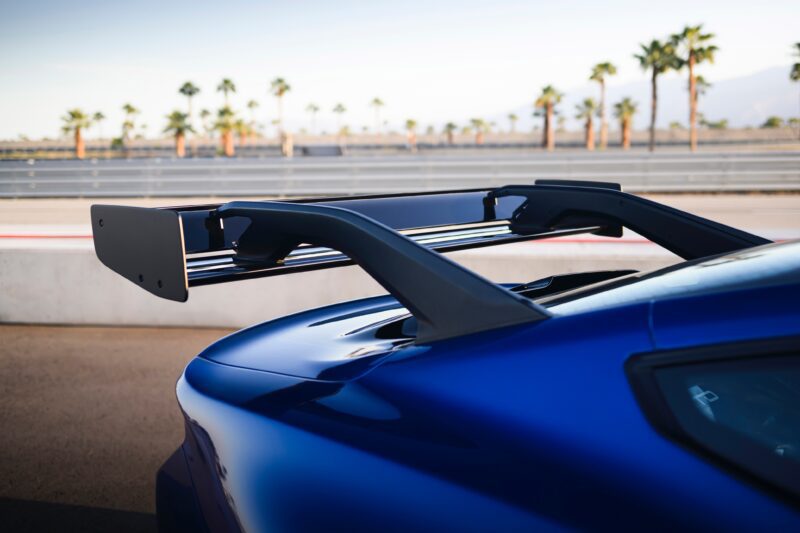
While the business may be in the front, the GTD’s party is definitely in the back. Due to the transaxle’s disruption of a space that was never intended to house it, Multimatic developed an inboard suspension system that leverages a similar setup to the late, great Ford GT’s. Using dual adaptive spool valve dampers, the suspension adjusts semi-actively within each drive mode. Also like the GT, a track mode (which requires the vehicle to be stopped and in Park to activate) drops the body dramatically in under 2.0 seconds, yielding a super low ride height and satisfyingly aggro wheel stance.
Incidentally, carbon fiber reinforcements mend the broken jigsaw puzzle of the GTD’s discombobulated rear end, lending it stiffer torsional rigidity than stock. They also crammed in heat exchangers to cool the transaxle, a massive active wing with DRS that mounts to the rear pillars, and the aforementioned pushrod suspension, which is visible inside the cabin through a Lexan window. Pro tip: Tilting the rearview mirror down while driving enables a clear view of the mesmerizing suspension kinematics. Don’t try this at home.

1 of 8

For all the visual theatre of the GTD’s flared, swollen, stanced, and steroidal body, the cabin is surprisingly – and disappointingly – normal. The usual Mustang bits abound, from the touchscreen display to the same HVAC implementation (which blows remarkably cold in 100+ degree weather, by the way) to the faux carbon fiber texture around part of the center console. Minor tweaks include the steering wheel’s adaptive cruise buttons, which have been repurposed to control the multi-stage traction control settings in Track mode.
Two days at the Thermal Club provide plenty of time to acclimate to the Alan Wilson-designed circuit in its maximum length, 5.1-mile IndyCar configuration, starting in Dark Horse Mustangs. Despite the annoyingly similar interiors, going from a $75,000, 500-horsepower Dark Horse to a $325,000, 815-horsepower GTD is like, well, going from a horse to a supercar.
The GTD’s supercharged V8 comes to life with a raw snarl, its titanium Akrapovič exhaust betraying its track-focused intentions. Surprisingly, though, it seems the supercharger whine has been quieted at speed. Despite this, there are a number of ways the GTD exceeds the GT3 race car. Though heavier, it also produces more power and boasts active aerodynamics and suspension. According to Goodall, the GT3 could outpace a GTD on smaller, more technical courses, though the GTD would likely get ahead on longer tracks.
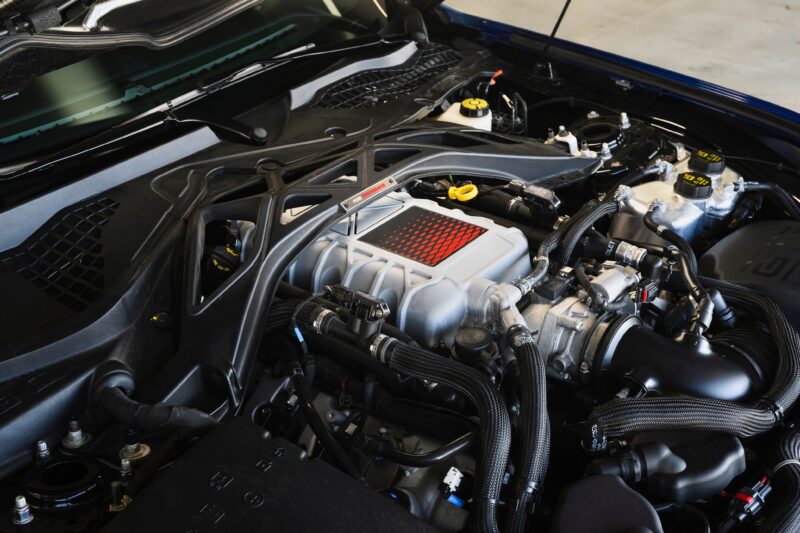
You’d never know the GTD weighs 4,386 lbs from the cradle of the specially developed Recaro driver’s seat; once accelerating, the V8’s tug is magnificent, the steering feel excellent, and the chassis and suspension remarkably agile. Overcook it into a corner, and a brake stab and steering adjustment tucks the ‘Stang back into form quickly.
This beast never feels like its mass is getting away from you, especially at higher speeds, since downforce escalates from 941 lbs at 125 mph all the way up to 1,951 lbs at 180 mph. Also commendable are the six-piston carbon ceramic Brembos, which produce powerful, easily modulated fade-free stops. Oh, and you can have any tire you want on the GTD… as long as it’s ultra-sticky Michelin Cup 2 Rs. As much as the GTD’s Hertz Rent-a-Car interior sends the wrong signals about its capabilities, its mercilessly aggressive bodywork and broad-shouldered stance sing to its true self.
And lest you suspect that well-heeled muscle car buyers will balk at the price, the order book is already full for the first two years of production. Fierce, controlled, and bombastic about performance, the GTD is the All-American M2 Browning .50 Cal to the GT3 RS’s Teutonic surgical scalpel. And if you’re wondering why Ford and Multimatic didn’t go even wilder with a full carbon fiber chassis, the answer is simple: it would no longer be a Mustang.
View All Ford Mustangs For Sale
